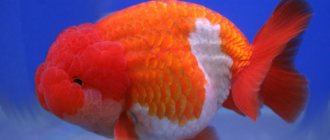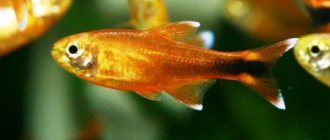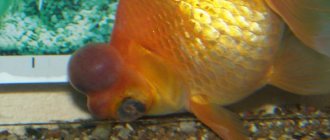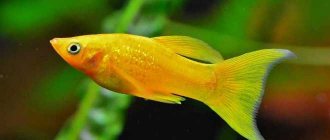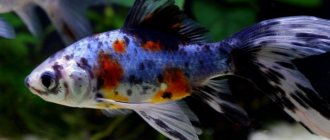Ryukin (Carassius gibelio forma auratus) Bloch 1782, one of the selected forms of aquarium goldfish - hardy and attractive, distinguished by a short body that is high in the back. Known as Riukin.
History of the species
The exact origin of the Ryukin goldfish has long been lost to history. However, they are believed to have originated in China and were introduced to Japan in the 1770s. Fish became very popular there. This is mentioned in early Japanese literature, where the ryukin is called onaga (long-tailed) or Nagasaki goldfish.
There are versions:
- The Ryukin breed of goldfish arose from the mutation of the long-finned Wakin. It was brought to Satsuma (Kagoshima Prefecture) from China between 1772 and 1788 via the Ryukyu Islands (Okinawa Prefecture), which lies between Taiwan and Japan. Because this goldfish was introduced through the Ryukyu region, it was named Ryukin.
- Ryukins are descended from the Fantail goldfish and were introduced to Japan in the mid-1700s. Their name comes from the Ryukyu Islands, but the breed is believed to have first appeared in China.
Of course, the Japanese put a lot of effort into improving Ryukin's characteristics, especially his dorsal hump and tall body. The history of cultivation of this breed exceeds 1000 years.
Habitat in nature
Like all varieties of goldfish, it is not found in nature. Ryukin was bred artificially, presumably in China, from where it came to Japan. The name of the fish itself can be translated from Japanese as “gold of the Ryukyu”.
Ryukyu is a group of islands in the East China Sea belonging to Japan.
Sources indicate that the fish came to Taiwan, and then to the Ryukyu Islands and in the main part of Japan they began to be named according to their place of origin.
The first mention of the breed dates back to 1833, although they came to Japan earlier.
Sexual differences and reproduction
Visually it is difficult to distinguish a female from a male. Only experienced aquarists can do this by examining the small notches on the male’s fins. To prevent premature spawning, males must be kept separate from females. The female, ready for reproduction, has a large abdomen filled with eggs.
Fish become sexually mature at the age of 1 year. They breed in April and May.
To breed for spawning, you need to leave one female and three males, and before that they must stay in different aquariums for about two weeks. In the spawning reservoir, the water temperature should be no lower than 24-26 degrees. To stimulate, the water needs to be heated gradually, increasing it by 5-10 degrees. The males will begin to chase the spawning female. After the end of the breeding season, males must be removed from the aquarium.
Description
The ryukin has a characteristic egg-shaped body that is short and stocky. The main feature that distinguishes it from the veiltail is its incredibly high back, which is even called a hump. It starts just behind the head, which makes the head itself look small and pointy.
Like the veiltail, the ryukin reaches a length of 15-18 cm, although in spacious reservoirs it can grow up to 21 cm. Life expectancy also varies.
On average, they live 12-15 years, but under good conditions they can live up to 20 years or more.
Another feature that makes the ryukin similar to the veiltail is the forked caudal fin. Moreover, it can be both long and short.
The color is varied, but red, red-white, white or black colors are more common.
Riukin
Ryukin is another breeding form of goldfish. It is believed that this breed was introduced to Japan around the sixteenth century from the Ryukyu Archipelago or in another reading Ryukiu. This is what the fish owes its name to.
We will probably never know the exact date of the start of keeping and breeding this fish in that area. We can only tentatively subtract from one to ten centuries from the known date. [sam_ad id=»15" codes=»true"] Some researchers consider the riukina to be the progenitor of the Japanese veiltail and oranda.
Riukin differs in that, being a short-bodied form, it is quite large in size and can reach twenty centimeters in length. Typically, short-bodied forms are smaller in size. Another distinctive feature of this breed is the elevation of the back, which immediately behind the head rises sharply, forming a kind of hump. The dorsal fin is erect on an elevated back. The color of riukin, like most species bred from goldfish, is varied, but red, silver and black colors predominate. The most common is riukin red. Riukin calico is very beautiful. The red and white riukin looks interesting especially in pools . The tail is forked and can be quite large. But it does not reach five to six body lengths, like the Japanese veiltail.
Due to its large body size, keeping it in an aquarium is problematic. Maximum of two fish per 100 liter aquarium. It is also necessary to regularly (once a week) replace one third of the water with fresh water. Constant aeration and filtration of water is highly desirable. In terms of food, he is not picky - bloodworms, large daphnia, earthworms, porridge, feeding with plant foods. Periodic feeding with special food for cold-water ornamental fish is also desirable.
The design of the aquarium can be varied. The soil is preferably fine and medium fractional. The presence of large stones with sharp edges and driftwood with sharp knots is not desirable. When selecting plants, it should be taken into account that riukin is not averse to profiting from them. And therefore, fast-growing plants, such as elodea, are desirable in the aquarium. Vallisneria and hornwort are suitable plants that take root in the soil. The aquarium lighting should be bright.
Water parameters do not differ from those for other breeds of goldfish, namely temperature 15 - 20°C, water hardness up to 20°dH, pH about 7.
[s[sam_ad id=»22" codes=»true»]p>
Due to its size, the riukin fish is more suitable for keeping in ponds and greenhouse decorative pools. And although in aquarium conditions riukin rarely reaches its maximum size, as it grows, it will quickly begin to experience a lack of space even in a hundred-liter aquarium.
Otherwise, maintenance and reproduction are the same as for other breeds of goldfish. You can see them in the article about goldfish. You just need to make an adjustment for its size.
Keeping in an aquarium
The most important thing to remember is that Ryukin is a large fish. A small, cramped aquarium is completely unsuitable for keeping such fish. Moreover, gold must be kept in quantity.
The recommended storage volume is 300 liters or more. If we are talking about several individuals, then the larger the volume, the larger, healthier, more beautiful fish you can grow.
Next in importance is filtration and water changes. All goldfish eat a lot, defecate a lot, and love to burrow in the substrate. In Soviet times they were called aquarium piglets.
Accordingly, maintaining balance in an aquarium with ryukins is much more difficult than with other fish.
A powerful external filter charged for biological and mechanical filtration is a must. Weekly water changes are mandatory.
Otherwise, a fairly unpretentious fish. Ideally, it should be kept in an aquarium without soil and plants. Soil is not needed, because fish dig in it constantly and can swallow small fractions.
Plants - because golden ones are not good friends with plants. If you plan to have plants in the aquarium, then you need large and hard-leaved species, such as Vallisneria or Anubias.
The fish can tolerate low temperatures, but the optimal temperature for keeping it will be 18°-22° C. At higher temperatures, life expectancy is reduced due to accelerated metabolism.
Behavior and Compatibility
Riukins are quite hardy and adapt well to various conditions.
They are hardier than the average goldfish and less susceptible to disease, making them great for both the pond and the home aquarium.
Despite their short body, these fish are quite active. They are much more active than other goldfish and are fun to watch. Can be kept with many other fish species with similar conditions, except the more aggressive ones.
The goldfish Ryukin feels best in groups of its own kind, although it can be kept alone without any problems. Still, they tend to be more confident and sociable when fish of the same species are nearby.
Choose non-aggressive fish of the same size. Weaker fish such as Stargazer Goldfish and Water Eyes are out of the question. Try these tankmates: Veiltail, Black Telescope, Ranchu, Oranda and the like.
Many algae eaters, including Gyrinocheilus and Plecostomus, pose a real problem for goldfish. These fish love to attach themselves to slow-moving fish and eat their mucous membrane. Ryukins are too slow to avoid, so much better algae control options are Ancitrus, Otocinclus or Siamese algae eaters for (tropical) goldfish aquariums.
To see if your Ryukins are healthy, it's worth paying attention to their color. They should always be brightly colored and nothing should cling to their scales. If you notice a decrease in appetite in your fish, this is an indication that they are not feeling well.
Feeding
Omnivores. In the aquarium they eat all types of food - live, artificial, frozen. Gluttons, capable of eating until they die. Feeding must be moderate.
Capable of eating small fish - guppies, neons and others.
The diet must contain plant foods. The structure of the fish intestines contributes to bloating, which leads to the death of the fish.
Plant foods normalize motor skills and promote the rapid passage of protein feed.
Breeding
Ryukin breed easily in an aquarium or pond if the water conditions are suitable.
In nature, they spawn in the spring, when the water warms up. To encourage spawning in an aquarium, you will need to replicate the same conditions.
Preparing for spawning is similar for all goldfish. Spawning aquarium from 50 liters, the fish must be healthy. Many breeders separate males and females for a week or two. Spawning tank with a separator net, one or two sprayers and a bunch of small-leaved plants in the center. Two males are placed per female or bred in a group of five individuals.
It doesn't take much effort to encourage Riukin to reproduce. All you need to do is make sure that the water parameters are suitable, and the fish will do the rest.
First you need to slowly reduce the water temperature to 15-16° C.
The next step is to gradually increase the water temperature, a little, by 1-2 degrees every day, until you reach 22-24 ° C. This will be enough to stimulate reproduction. Increasing the temperature is necessary to imitate natural changes in nature.
At this time, the fish should eat well, with food high in protein, such as bloodworms. When you see males chasing females around a pond or aquarium, it means everything has worked out and breeding is about to begin.
Spawning can last several days, during which the male pursues the female. Eventually, the female lays eggs, which are then fertilized by the male. The eggs stick to smooth surfaces or plant leaves. Fertility up to 10,000 eggs.
Riukins tend to eat eggs. Therefore, after spawning, it is best to remove the producers. The larva appears after 2 days, the fry will swim freely for 5-7 days, depending on the water temperature. Starter food - live dust, special food for fry. As they grow - Artemia nauplii, crushed dry food.
At first the fry are dark brown or black in color. After a few months, the fish will acquire the coloration of adults. As soon as the juveniles grow to about 3 cm, they can be placed in an aquarium with larger fish.
Labeo
A very impressive fish that is not easy to find in pet stores. Two-color beauties captivate at first sight. And if a person already has an aquarium, most likely the owner will want to immediately take such a curiosity for himself. It's better to stop and try to find out more about your potential pet. A black aquarium fish with a red tail is extremely attractive, but if you already have underwater inhabitants at home, then you should refuse the purchase.
Labeo is a solitary fish. Experts in this field note that they have never encountered aquariums where two adults or even teenagers coexisted peacefully. Fry up to two centimeters in size are usually sold at the market. Less common are grown ones, 7-10 cm long. And it’s very rare to see adult fish. A consultant selling fry usually claims that they can be kept in a small aquarium, several at a time. What happens next? As they grow up, they will begin to fight to the death for territory. These charming red and black aquarium fish should live alone, in a container with a volume of at least 100 liters.
Labeo is a natural inhabitant of bottom layers, so it is extremely undesirable for catfish to live with them at the same depth. It is better to choose the inhabitants of the upper layers as neighbors, for example neons or barbs. Then they will practically not intersect. Representatives of the family prefer plant foods, but do not refuse food of animal origin.
When to fertilize the garden in the fall?
It is advisable to apply fertilizers early in the fall, before the ground freezes. Usually the soil is fertilized before the third ten days of December; soil fertilization is not carried out later. After applying any fertilizers, it is advisable to make a mulch of compost a couple of centimeters thick; the compost and roots will be protected from freezing in case frost comes to the ground that is not yet covered with snow, and in the spring, with the active melting of the snow, it will provide additional nutrition.
Do not forget that autumn is almost the most favorable time for enriching the soil with nutrition for most plants; in the spring they will begin to grow, consuming from the soil the nutrients already provided by caring owners.
Goldfish Compatibility
The issue of compatibility of aquarium fish is controversial. Due to the uniqueness of each body of water, the characteristics of the species and the individual situation, too many factors influence the result. For example, when an amateur wants to keep closely related species or even breeding forms in the same body of water, some specimens come across as overly aggressive. So, here are the main parameters:
- Peaceful individuals.
- Lack of intraspecific aggression.
- Same size fish - put large creatures with large ones.
- Young specimens. The fry get along better with each other than the adults.
- The nature of the settlement. It is advisable to settle young people at the same time, and not place young individuals with “old people”. The fish immediately get used to each other, so there are fewer reasons for conflicts.
- Same conditions of detention. Riukin is relatively unpretentious; orandas are considered more capricious fish to keep.
Dermatomycosis
This is a fungal disease of freshwater fish. Most often, it affects individuals whose bodies are already weakened as a result of some illness, injury or poor living conditions.
With this disease, thin white threads appear on the fish’s body, fins and gills, which grow perpendicular to the body. If the cause of the disease is not eliminated at this point, the threads will quickly develop into a cotton wool-like coating. The fungus grows into the muscles and internal organs of the fish, as a result of which it becomes inactive and lies on the bottom.
In the initial stages, the disease can be stopped. To do this, dilute a 5% solution of table salt in a separate aquarium and “bathe” the fish in it for 5 minutes. You should also increase the water temperature and increase its aeration.
In addition, it is necessary to determine the cause of the disease. If this is not the correct fish keeping, it should be improved dramatically. But if dermatomycosis is only a consequence of another disease, you must immediately begin to eliminate the original disease.
Treatment of dermatomycosis can be carried out in a common aquarium. Common medications recommended are copper sulfate, potassium permanganate, and basic violet K. When using branded medications, Fungus Cure from Aquarium Pharmaceuticals, INC, Sera mycopur, Sera ectopur, Sera acutan, Tetra General Tonic Plus, and Tetra Medica FungiStop have performed well. The above products should be used according to the manufacturer's instructions.
Literature[n[edit]>- Yoshiichi Matsui Goldfish guide. — 2nd. - Neptune, NJ: TFH Publications, 1981. - P. 51. - ISBN 9780876665459 > (English)
- Andrews, Chris, Dr. An Interpeting Guide to Fancy Goldfish. - Interpet Publishing, 2002. - ISBN 1-902389-64-6 > (English)
- Johnson, Erik L., Dr. DVM and Richard E. Hess Fancy Goldfish: A Complete Guide to Care and Collecting. - Weatherhill: Shambhala Publications, Inc., 2006. - ISBN 0-8348-0448-4 > (English)
- Japanese journal of Ichthyology, vol 19 no 4 December,25 1972 Variations of Spinal curvature and veterinary number in Goldfish.
- Ryukin (English)
Gasteroenteritis
This disease has a second name - inflammation of the stomach. It occurs when goldfish are overfed with poor-quality food, as well as when they are fed monotonously with dried daphnia, gammarus and bloodworms.
A sick fish does not lose its appetite and eats well for a very long time. But at the same time its activity decreases. The individual's abdomen swells slightly and the anus turns red, and the excrement becomes thread-like and contains bloody mucus.
But this disease is easily curable by simply fasting for a week. Sick fish should be transferred to a separate aquarium with fresh water, to which a weak solution of potassium permanganate is added. It is also necessary to increase the aeration of the water and raise its temperature by about 2-3 degrees.
Description[n[edit]>
A fish with an elegant short egg-shaped and swollen body, massive fins. The total length of the fish is about 20 cm. The ratio of height to body length is from 3/4 to 1. The head is large, with slightly enlarged eyes. The back is curved in the form of a “hump”, starting from the head to the dorsal fin. The length of the fins largely determines the value of the specimen. The dorsal fin is strictly vertical - from 1/3 or more of the body height. The tail is forked and widely spread: in relation to the length of the body, it ranges from 3/4 to one and a half (1.5) sizes. The angle between the upper and lower blades of the caudal fin is 90º or more. The remaining fins are paired, of moderate length, with slightly rounded tips.
Color[ed[edit]>
The colors of ryukin are varied: red, pink or white, multi-colored with spots and “chintz”.
Behavior[ed[edit]>
Slow. Does not tolerate low water temperatures. Keeping it in open water is not recommended. The aquarium must be heated.

